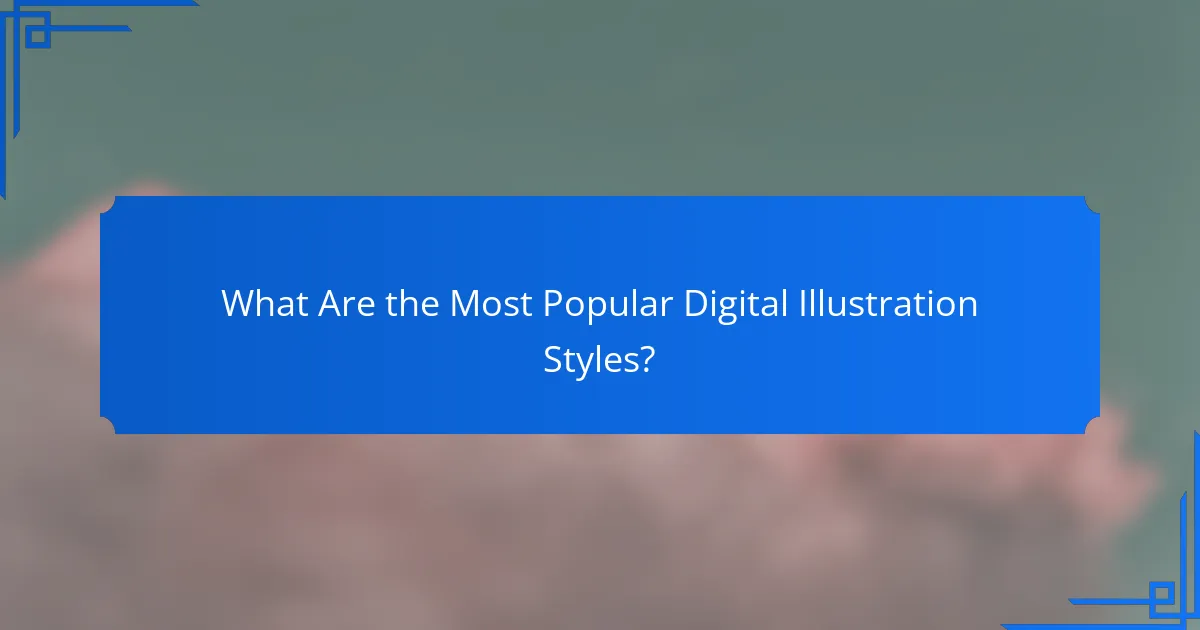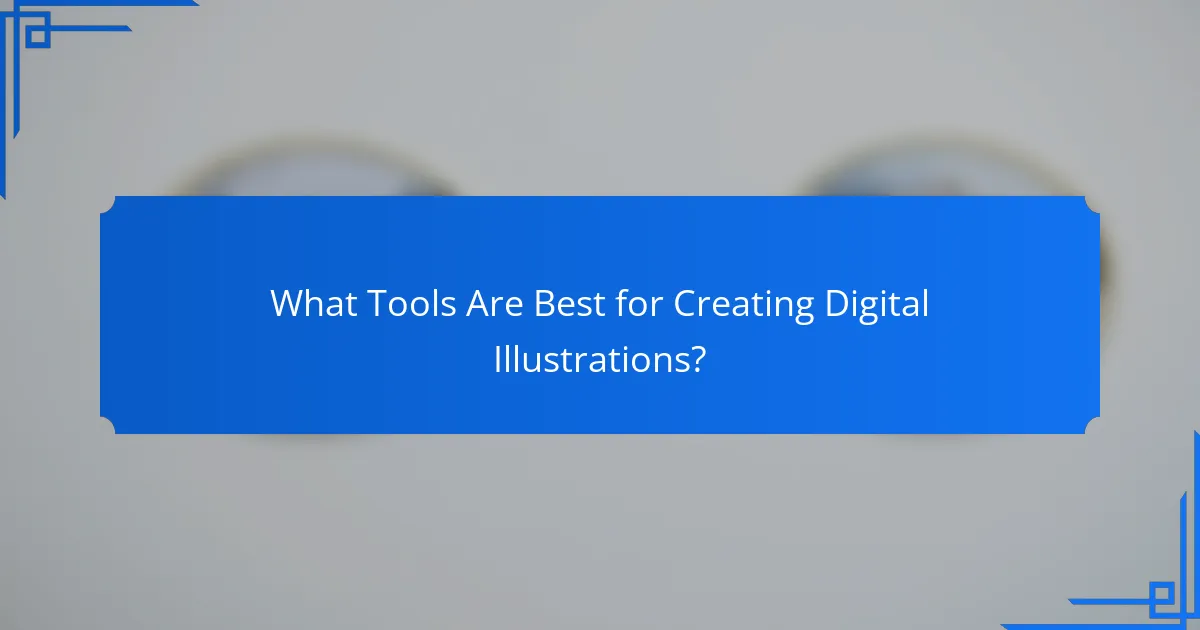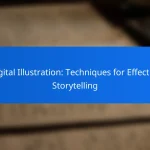In the world of digital design, choosing the right illustration style is crucial for creating eye-catching graphics that resonate with your audience. From bold and vibrant to subtle and sophisticated, each style offers unique characteristics tailored to various branding and advertising needs. Understanding these styles can enhance your project’s effectiveness, ensuring your visuals communicate your message clearly and engagingly.

What Are the Most Popular Digital Illustration Styles?
The most popular digital illustration styles include various techniques that cater to different aesthetic preferences and project requirements. Each style has unique characteristics, making them suitable for specific applications in branding, advertising, and digital art.
Flat Design
Flat design is characterized by its minimalism and use of two-dimensional elements without any gradients or shadows. This style emphasizes simplicity and clarity, making it ideal for user interfaces and web design.
When using flat design, focus on bold colors and clear typography. Avoid overly complex shapes to maintain the style’s clean look. Examples include app icons and website graphics that prioritize functionality alongside visual appeal.
3D Illustration
3D illustration creates depth and realism by simulating three-dimensional objects and environments. This style is often used in product visualization, gaming, and animation, providing a lifelike experience for viewers.
To effectively use 3D illustration, consider the balance between detail and performance, especially for web applications. Tools like Blender or Cinema 4D can help create stunning visuals, but be mindful of file sizes for faster loading times.
Vector Art
Vector art is created using mathematical equations to form shapes, allowing for scalability without loss of quality. This style is perfect for logos, icons, and illustrations that need to be resized for various applications.
When creating vector art, utilize software like Adobe Illustrator to take advantage of its precision and flexibility. Keep in mind that vector graphics are best for simpler designs; intricate details may require raster images instead.
Hand-Drawn Style
Hand-drawn style mimics traditional drawing techniques, giving illustrations a personal and organic feel. This style is often used in children’s books, branding, and social media graphics to evoke warmth and creativity.
To achieve a hand-drawn look, use digital tools that replicate pencil or ink textures. Be cautious of over-complicating designs; simplicity often enhances the charm of hand-drawn illustrations.
Isometric Design
Isometric design presents three-dimensional objects in two dimensions, using parallel lines to create a sense of depth. This style is commonly used in infographics, game design, and architectural illustrations.
When working with isometric design, maintain consistent angles and proportions to ensure clarity. Use grid systems to help align elements accurately, and consider color schemes that enhance the dimensionality of your illustrations.

How to Choose the Right Illustration Style for Your Project?
Selecting the right illustration style for your project involves understanding your brand identity, the preferences of your target audience, and the overall purpose of your project. A well-chosen style enhances communication and resonates with viewers, making your graphics more effective.
Consider Your Brand Identity
Your brand identity should guide your choice of illustration style. For example, a tech company may opt for sleek, modern graphics, while a children’s brand might choose playful, colorful illustrations. Consistency in style reinforces brand recognition and trust.
Evaluate your brand colors, fonts, and overall aesthetic to ensure the illustration style aligns with your existing visual identity. This coherence helps create a unified message across all marketing materials.
Target Audience Preferences
Understanding your target audience is crucial when selecting an illustration style. Different demographics respond to various artistic approaches; for instance, younger audiences may prefer vibrant, trendy styles, while older audiences might appreciate more classic or minimalist designs.
Conduct surveys or focus groups to gather insights on what styles resonate with your audience. This feedback can guide your decision and help ensure that your illustrations engage effectively.
Project Purpose and Message
The purpose of your project significantly influences the illustration style you should choose. For instance, if your goal is to convey a serious message, a more subdued and professional style may be appropriate. Conversely, if you aim to inspire creativity or fun, a bold and whimsical style could be more effective.
Clearly define the message you wish to communicate and select an illustration style that enhances this message. Consider creating a mood board to visualize how different styles can align with your project’s objectives.

What Are the Key Benefits of Using Digital Illustrations?
Digital illustrations offer numerous advantages, including enhanced engagement and the ability to convey complex ideas visually. By integrating illustrations into your content, you can capture attention and communicate messages more effectively.
Enhanced Visual Appeal
Digital illustrations significantly boost the visual appeal of graphics, making them more attractive to viewers. This heightened appeal can lead to increased interest and interaction with your content.
Consider using vibrant colors, unique styles, and imaginative designs to create illustrations that stand out. For example, a bright, playful illustration can make a children’s book cover more inviting compared to a standard photograph.
Improved Brand Recognition
Utilizing digital illustrations can strengthen brand recognition by creating a distinctive visual identity. Consistent use of specific styles or themes in illustrations helps audiences associate those visuals with your brand.
For instance, a tech company may use sleek, modern illustrations to convey innovation, while a bakery might opt for warm, inviting designs that evoke comfort. This strategic alignment enhances memorability and fosters loyalty.
Versatility Across Platforms
Digital illustrations are highly versatile, making them suitable for various platforms, including websites, social media, and print materials. Their adaptability allows brands to maintain a cohesive visual identity across different channels.
When designing illustrations, consider the specific requirements of each platform. For example, simpler designs may work better for social media, while detailed illustrations can shine in print advertising. This flexibility ensures your graphics remain effective regardless of the medium.

What Tools Are Best for Creating Digital Illustrations?
The best tools for creating digital illustrations include software that offers versatility, ease of use, and a range of features tailored for artists. Popular options like Adobe Illustrator, Procreate, and CorelDRAW each provide unique capabilities suited for different styles and workflows.
Adobe Illustrator
Adobe Illustrator is a leading vector graphics editor favored by professionals for its precision and scalability. It allows artists to create designs that can be resized without losing quality, making it ideal for logos, icons, and illustrations that require sharp lines.
Key features include a comprehensive set of drawing tools, advanced typography options, and integration with other Adobe products. However, it requires a subscription, which can be a consideration for budget-conscious users.
Procreate
Procreate is a popular choice among digital illustrators, especially for those using iPads. It offers a user-friendly interface and a wide array of brushes and tools that mimic traditional drawing techniques, making it perfect for sketching and painting.
Its one-time purchase model is appealing, and the app supports high-resolution canvases, allowing for detailed artwork. However, it is limited to Apple devices, which may restrict access for some users.
CorelDRAW
CorelDRAW is another powerful vector graphic design software that is known for its intuitive interface and robust feature set. It is particularly strong in layout design and offers tools for both vector and raster graphics, making it versatile for various illustration needs.
CorelDRAW is available through a one-time purchase or subscription, providing flexibility for users. It is widely used in print design, but some users may find the learning curve steeper compared to other tools like Procreate.

What Are the Trends in Digital Illustration Styles for 2024?
In 2024, digital illustration styles are increasingly focused on immersive experiences and simplicity. Key trends include augmented reality integration and minimalist aesthetics, which cater to modern visual communication needs.
Augmented Reality Integration
Augmented reality (AR) integration in digital illustrations enhances user engagement by blending digital elements with the real world. This style allows artists to create interactive experiences that can be accessed through smartphones or AR glasses, making illustrations come alive.
To effectively implement AR, consider the target audience and the platforms they use. For instance, brands in retail and entertainment are leveraging AR to create immersive marketing campaigns. Tools like Adobe Aero and Unity can help artists design AR experiences without extensive coding knowledge.
Minimalist Aesthetics
Minimalist aesthetics emphasize simplicity and clarity, focusing on essential elements to convey messages effectively. This style often utilizes limited color palettes, clean lines, and ample white space, making it visually appealing and easy to understand.
When adopting a minimalist approach, prioritize strong typography and basic shapes. This can enhance brand recognition and improve user experience. Avoid clutter and unnecessary details to maintain focus on the core message, which is particularly effective in digital platforms where attention spans are short.


